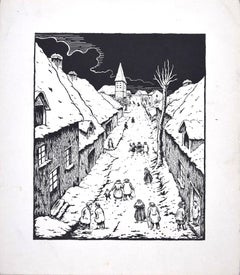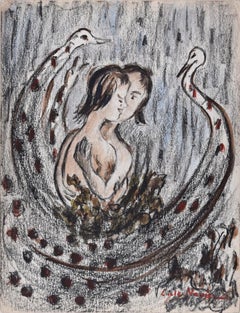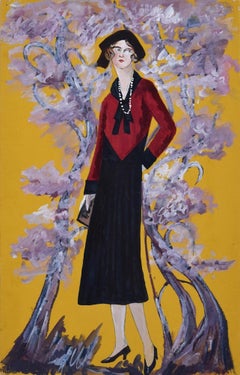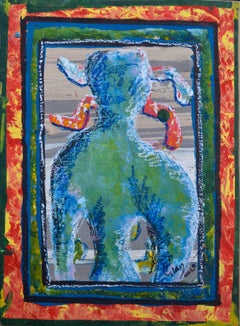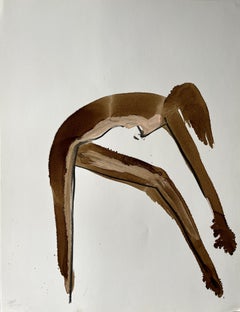Lucie Navier Art
to
3
8
5
3
8
Overall Height
to
Overall Width
to
5
6
4
4
2
2
1
1
1
1
1
1
1
1
1
1
1
8
1
7
8
6,958
3,340
2,513
1,213
7
5
2
2
2
Artist: Lucie Navier
Poseidon - Ink and Tempera on Paper by Lucie Navier - 1933
By Lucie Navier
Located in Roma, IT
Poseidon is an original painting realized by Lucie Navier in 1933.
Original Ink and tempera painting on paper.
Dated on the lower right corner (23-6-2033).
Fair conditions except...
Category
1930s Modern Lucie Navier Art
Materials
Tempera, Watercolor, Ink
Marine - Tempera on Paper by Lucie Navier - 1927
By Lucie Navier
Located in Roma, IT
Marine is a painting realized by Lucie Navier in the 1927.
Tempera on paper.
Mint conditions.
Impressionistic work realized with a Realistic technique and representing a natural...
Category
1920s Modern Lucie Navier Art
Materials
Tempera
Nocturnal Village - Original Screen Print by Lucie Navier
By Lucie Navier
Located in Roma, IT
Nocturnal Village is an original artwork realized by the French artist Lucie Navier (1910-1996) in the 1930s.
Original black and white serigraph...
Category
1930s Modern Lucie Navier Art
Materials
Screen
Peacocks - Original Mixed Media on Paper by Lucie Navier - 1930s
By Lucie Navier
Located in Roma, IT
Peacocks is a painting realized by Lucie Navier in the 1930s.
Original tempera painting and pastels on cardboard.
Hand-signed by the artist on the lower right corner in red paintin...
Category
1930s Modern Lucie Navier Art
Materials
Tempera, Pastel
Madame in the Blossom Garden - Tempera on Paper by Lucie Navier - 1931
By Lucie Navier
Located in Roma, IT
Madame in the blossom garden is an original painting realized by Lucie Navier in the 1931.
Original tempera on paper.
Very good conditions.
Colorful composition representing a f...
Category
1930s Modern Lucie Navier Art
Materials
Tempera
Muslim - Original Mixed Media on Paper by Lucie Navier - 1930s
By Lucie Navier
Located in Roma, IT
Muslim is an original painting realized by Lucie Navier.
Original tempera painting on paper. The sheet is glued on green cardboard (cm 30.5 x 25).
Very good conditions.
Colorful ...
Category
1930s Lucie Navier Art
Materials
Tempera, Watercolor, Ink
Young Blonde Girl - Original Oil on Cardboard by Lucie Navier - 1930s
By Lucie Navier
Located in Roma, IT
Young Blonde Girl is an original painting realized by Lucie Navier in the 1930s.
Original oil painting on cardboard.
Hand-signed by the artist on the lo...
Category
1930s Lucie Navier Art
Materials
Oil
In the Woods - Original Oil Painting by Lucie Navier - 1931
By Lucie Navier
Located in Roma, IT
In the Woods is an original painting realized by Lucie Navier in the 1931.
Original oil painting on cardboard.
Hand-signed on the lower right corner.
Very good conditions.
Col...
Category
1930s Lucie Navier Art
Materials
Oil, Cardboard
Related Items
"Strong Arm" Figurative Abstract
Located in Soquel, CA
Bright figurative abstract with rich layers of texture and color by Chaz Cole (American, 20th Century). Irregular perimeter. Signed and dated "Chaz Cole" lower right. Signed and date...
Category
1990s Abstract Expressionist Lucie Navier Art
Materials
Pastel, Tempera, Cardboard
"Side Stretch Nude" 1984 Figure Gouache and Pastel American Modernist
By Jack Hooper
Located in Arp, TX
Jack Hooper
"Side Stretch Nude"
9/7/1984
Gouache and pastel on paper
20"x26" unframed
Signed and dated in pencil lower left
In this intriguing modernist artwork, Jack Hooper's minim...
Category
1980s American Modern Lucie Navier Art
Materials
Paper, Pastel, Gouache
No Reserve
H 26 in W 20 in
Crowing Glory, Anne Storno, Pop art, Limited edition print for sale, The Queen
By Anne Storno
Located in Deddington, GB
Crowning glory by Anne Storno
Hand printed, limited edition screen print.
Sold unframed
Image size: H:30cm x W:30cm
Complete size of unframed work: H:30cm x W:30cm x D:0.1cm
Please note that insitu images are purely an indication of how a piece may look
Created from a hand made paper collage and spray painting mixed media work that has been transformed into a screen print.Queen Elizabeth is surrounded by famous London’s place : St Paul’s Cathedral, Big Ben, London Bridge, London Eye, Carnaby Street and also David Bowie’s portrait...
Category
21st Century and Contemporary Pop Art Lucie Navier Art
Materials
Paper, Screen
H 11.82 in W 11.82 in D 0.04 in
Harry Shokler, Island Harbor
By Harry Shokler
Located in New York, NY
Harry Shokler used serigraphy to great advantage in this landscape. It's colorful and detailed.
It is signed in the image at the lower left. When printmakers began making serigraphs...
Category
1940s American Modern Lucie Navier Art
Materials
Screen
Modernist Silkscreen Screenprint 'El Station, Interior' NYC Subway, WPA Artist
By Anthony Velonis
Located in Surfside, FL
screenprint printed in color ink on wove paper. New York City subway station interior.
Anthony Velonis (1911 – 1997) was an American painter and designer born in New York City who helped introduce the public to silkscreen printing in the early 20th century.
While employed under the federal Works Progress Administration, WPA during the Great Depression, Velonis brought the use of silkscreen printing as a fine art form, referred to as the "serigraph," into the mainstream. By his own request, he was not publicly credited for coining the term.
He experimented and mastered techniques to print on a wide variety of materials, such as glass, plastics, and metal, thereby expanding the field. In the mid to late 20th century, the silkscreen technique became popular among other artists such as Robert Rauschenberg and Andy Warhol.
Velonis was born into a relatively poor background of a Greek immigrant family and grew up in the tenements of New York City. Early on, he took creative inspiration from figures in his life such as his grandfather, an immigrant from the mountains in Greece, who was "an ecclesiastical painter, on Byzantine style." Velonis attended James Monroe High School in The Bronx, where he took on minor artistic roles such as the illustration of his high school yearbook. He eventually received a scholarship to the NYU College of Fine Arts, into which he was both surprised and ecstatic to have been admitted. Around this time he took to painting, watercolor, and sculpture, as well as various other art forms, hoping to find a niche that fit. He attended NYU until 1929, when the Great Depression started in the United States after the stock market crash.
Around the year 1932, Velonis became interested in silk screen, together with fellow artist Fritz Brosius, and decided to investigate the practice. Working in his brother's sign shop, Velonis was able to master the silkscreen process. He reminisced in an interview three decades later that doing so was "plenty of fun," and that a lot of technology can be discovered through hard work, more so if it is worked on "little by little."
Velonis was hired by Mayor LaGuardia in 1934 to promote the work of New York's city government via posters publicizing city projects. One such project required him to go on a commercial fishing trip to locations including New Bedford and Nantucket for a fortnight, where he primarily took photographs and notes, and made sketches. Afterward, for a period of roughly six months, he was occupied with creating paintings from these records. During this trip, Velonis developed true respect and affinity for the fishermen with whom he traveled, "the relatively uneducated person," in his words.
Following this, Velonis began work with the Public Works of Art Project (PWAP), an offshoot of the Civil Works Administration (CWA), where he was assigned to serve the different city departments of New York. After the formation of the federal Works Progress Administration, which hired artists and sponsored projects in the arts, he also worked in theater.
Velonis began working for the federal WPA in 1935. He kept this position until 1936 or 1938, at which point he began working in the graphic art division of the Federal Art Project, which he ultimately led. Under various elements of the WPA program, many young artists, writers and actors gained employment that helped them survive during the Depression, as well as contributing works that created an artistic legacy for the country.
When interviewed in December 1994 by the Library of Congress about his time in the WPA, Velonis reflected that he had greatly enjoyed that period, saying that he liked the "excitement" and "meeting all the other artists with different points of view." He also said in a later interview that "the contact and the dialogue with all those artists and the work that took place was just invaluable." Among the young artists he hired was Edmond Casarella, who later developed an innovative technique using layered cardboard for woodcuts.
Velonis introduced silkscreen printing to the Poster Division of the WPA. As he recalled in a 1965 interview: "I suggested that the Poster division would be a lot more productive and useful if they had an auxiliary screen printing project that worked along with them. And apparently this was very favorably received..."
As a member of the Federal Art Project, a subdivision of the WPA, Velonis later approached the Public Use of Arts Committee (PUAC) for help in "propagandizing for art in the parks, in the subways, et cetera." Since the Federal Art Project could not be "self-promoting," an outside organization was required to advertise their art more extensively. During his employment with the Federal Art Project, Velonis created nine silkscreen posters for the federal government.
Around 1937-1939 Velonis wrote a pamphlet titled "Technical Problems of the Artist: Technique of the Silkscreen Process," which was distributed to art centers run by the WPA around the country. It was considered very influential in encouraging artists to try this relatively inexpensive technique and stimulated printmaking across the country.
In 1939, Velonis founded the Creative Printmakers Group, along with three others, including Hyman Warsager. They printed both their own works and those of other artists in their facility. This was considered the most important silkscreen shop of the period.
The next year, Velonis founded the National Serigraph Society. It started out with relatively small commercial projects, such as "rather fancy" Christmas cards that were sold to many of the upscale Fifth Avenue shops...
Category
1980s American Modern Lucie Navier Art
Materials
Screen
Original "Wagon Lits" pop art style serigraph travel by train poster
By Valerio Adami
Located in Spokane, WA
Original “Wagon Lits” serigraph poster by the artist Valerio Adami.
It was printed in France by GrafiCaza (Michel Caza), one of the finest serigraph companies on woven paper—in exce...
Category
1990s American Modern Lucie Navier Art
Materials
Screen
H 36 in W 24 in D 0.05 in
The biggest house in town - Figurative Gouache Painting, Landscape, Architecture
By Piotr Fąfrowicz
Located in Warsaw, PL
PIOTR FĄFROWICZ (born in 1958). He studied art history at the Catholic University of Lublin. He deals with painting and graphic design. Winner of numerous awards for illustrations, i...
Category
21st Century and Contemporary Other Art Style Lucie Navier Art
Materials
Paper, Tempera, Gouache
"Side Stretch Nude 2" 1984 Figure Gouache and Pastel American Modernist
By Jack Hooper
Located in Arp, TX
Jack Hooper
"Side Stretch Nude 2"
9/7/1984
Gouache and pastel on paper
20"x26" unframed
Signed and dated in pencil lower right
In this modernist masterpiece, Jack Hooper deftly navi...
Category
1980s American Modern Lucie Navier Art
Materials
Paper, Pastel, Gouache
No Reserve
H 26 in W 20 in
UN Poster Design American Scene Mid 20th Century Modernism WPA World Peace
By Jo Cain
Located in New York, NY
UN Poster Design American Scene Mid 20th Century Modernism WPA World Peace
Jo Cain (1904 – 2003)
We Are All Members of the Human Race: UN Poster Proposal
21 x...
Category
1940s American Modern Lucie Navier Art
Materials
Board, Egg Tempera
Americana, Lawyer in Court, Politician, Gouache Painting WPA Art William Gropper
By William Gropper
Located in Surfside, FL
William Gropper Original Gouache on Paper
Hand signed lower right
33.5 x 27.5 image 26 x 20.5
The New-York born artist William Gropper was a painter and cartoonist who, with caricature style, focused on social concerns, and was actively engaged in support of the organized labor movement throughout his career. This original watercolor drawing is done in the iconic style of the artist's oeuvre.
Born to Harry and Jenny Gropper in 1897, William was raised in New York City's Lower East Side. His parents were Jewish immigrants from Romania and Ukraine, and young William grew up in relative poverty, watching his family struggle to achieve that sought-after American dream. His father, a bright and college-educated man, was unable to find employment that worthy of his intellect. His mother, meanwhile, worked as a seamstress from home. Coupled with the devastating loss of an aunt to the infamous Triangle Factory fire of 1911, significant childhood factors created the foundation that led to Gropper’s exploration of the American experience.
Early on, Gropper displayed an extraordinary, natural skill for art. By 1912, he was already studying under the instruction of George Bellows and Robert Henri at the Ferrer School in Greenwich Village. During his time at school, Gropper was also awarded a prestigious scholarship to study at the National Academy of Design. However, he refused to fit into convention and was swiftly expelled from the Academy. After his expulsion, Gropper returned home to help financially by assisting his mother and taking a shop position. However, he didn't abandon art academia and soon presented a portfolio to the New York School of Fine Art which earned him a scholarship for study.
Gropper obtained his first significant job as a cartoonist for the New York Tribune in 1917. While working as a staff cartoonist for the Tribune, he also contributed drawings to publications like Vanity Fair, New Masses, The Nation, and Freiheit. His interest in the welfare of the American worker, class inequality, and social injustice was central in his work. After publishing the graphic novel Alley Oop in 1930, Gropper's illustration career extended well into the decade. However, he was never exempt from controversy, and his 1935 Vanity Fair cartoon; prompted anger from the Japanese government.
As an involved labor organizer and Social Realist activist, Gropper continued to bring attention to his radical reputation with visits to the Soviet Union and Poland. However, his concern with European politics and U.S. social causes didn't slow down his artistic career, and by the late 1930s, he had produced significant murals for American cities like Washington D.C. His 1938 mural Construction of a Dam was commissioned for the Department of the Interior and represents the Social-Realism style that depicts experiences of the worker and everyday societal life. Measuring at a staggering 27ft by 87ft, the piece portrays muscular, robust American laborers scaling rocky hillsides, building infrastructure, and operating heavy machinery. The mural feels undeniably American with golden scenery, denim blues, and steely gray colors. Gropper fits perfectly into Social-Realism because the style exhibits an illustrative flair with strong lines and simple, bold hues.
The inspiration for Construction of a Dam sprang from his 1937 travels to the poverty-stricken Dust Bowl area. The trip was sponsored by a Guggenheim Foundation Fellowship, and his drawings of the Grand Coulee and Boulder Dams...
Category
Mid-20th Century Modern Lucie Navier Art
Materials
Ink, Watercolor, Gouache
Japanese Contemporary Art by Miyuki Takanashi - Holding Knee
By Miyuki Takanashi
Located in Paris, IDF
Tempera, ink & egg emulsion
Miyuki Takanashi is a Japanese artist born in 1961 who lives & works in Sapporo in Japan. She is graduated from Hokkaido University of Education Iwamiza...
Category
2010s Contemporary Lucie Navier Art
Materials
Ink, Tempera, Canvas, Emulsion
H 13.15 in W 9.57 in D 1.19 in
Birds in Flight
Located in Buffalo, NY
A modern Chinese watercolor painting depicting birds soaring under a red sun.
Category
1970s Modern Lucie Navier Art
Materials
Archival Paper, Archival Ink, Watercolor
Lucie Navier art for sale on 1stDibs.
Find a wide variety of authentic Lucie Navier art available for sale on 1stDibs. You can also browse by medium to find art by Lucie Navier in paint, tempera, ink and more. Much of the original work by this artist or collective was created during the 20th century and is mostly associated with the modern style. Not every interior allows for large Lucie Navier art, so small editions measuring 7 inches across are available. Customers who are interested in this artist might also find the work of Jane Levy, Etienne Ret, and Louis Toffoli. Lucie Navier art prices can differ depending upon medium, time period and other attributes. On 1stDibs, the price for these items starts at $145 and tops out at $440, while the average work can sell for $273.


